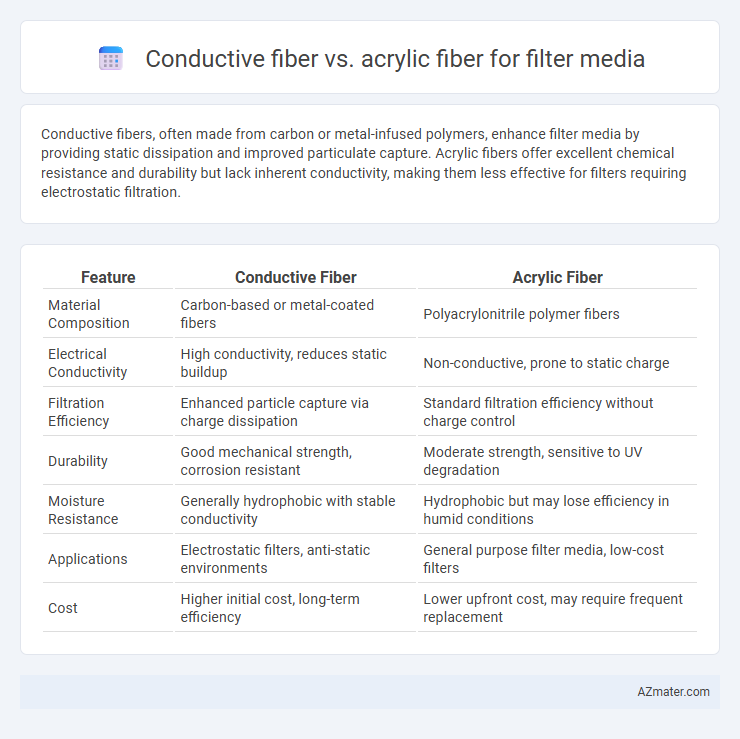Conductive fibers, often made from carbon or metal-infused polymers, enhance filter media by providing static dissipation and improved particulate capture. Acrylic fibers offer excellent chemical resistance and durability but lack inherent conductivity, making them less effective for filters requiring electrostatic filtration.
Table of Comparison
| Feature | Conductive Fiber | Acrylic Fiber |
|---|---|---|
| Material Composition | Carbon-based or metal-coated fibers | Polyacrylonitrile polymer fibers |
| Electrical Conductivity | High conductivity, reduces static buildup | Non-conductive, prone to static charge |
| Filtration Efficiency | Enhanced particle capture via charge dissipation | Standard filtration efficiency without charge control |
| Durability | Good mechanical strength, corrosion resistant | Moderate strength, sensitive to UV degradation |
| Moisture Resistance | Generally hydrophobic with stable conductivity | Hydrophobic but may lose efficiency in humid conditions |
| Applications | Electrostatic filters, anti-static environments | General purpose filter media, low-cost filters |
| Cost | Higher initial cost, long-term efficiency | Lower upfront cost, may require frequent replacement |
Introduction to Conductive and Acrylic Fibers in Filter Media
Conductive fibers in filter media offer enhanced static dissipation and improved particle capture efficiency compared to traditional materials, making them ideal for applications requiring electrostatic filtration. Acrylic fibers, characterized by their excellent chemical resistance and durability, provide a robust and versatile option in filter media for trapping fine particulates and contaminants. Combining conductive fibers with acrylic fibers in filter media can optimize filtration performance by balancing electrostatic properties and mechanical strength.
Composition and Manufacturing Processes
Conductive fiber for filter media typically consists of carbon-infused polymers or metal-coated fibers, providing enhanced electrical conductivity and static dissipation properties. Acrylic fiber, primarily made from polyacrylonitrile, undergoes wet or dry spinning processes to create fine, stable fibers with excellent chemical resistance and hydrophobicity. The manufacturing of conductive fibers involves integration of conductive materials during polymerization or post-treatment coating, whereas acrylic fibers are synthesized through controlled polymerization and precise fiber extrusion techniques, optimizing their filtration efficiency and longevity.
Electrical Properties and Conductivity
Conductive fiber exhibits superior electrical properties and high conductivity due to its intrinsic ability to allow electron flow, making it ideal for applications requiring efficient electrostatic dissipation in filter media. Acrylic fiber, in contrast, has low electrical conductivity and functions mainly as a non-conductive, insulating material, limiting its use in electrically sensitive filtration systems. The enhanced conductivity of conductive fibers enables better charge control and improved performance in filters exposed to electrostatic environments.
Filtration Efficiency Comparison
Conductive fibers exhibit superior filtration efficiency compared to acrylic fibers due to their enhanced ability to dissipate static charges, which reduces particle adhesion and improves particle capture. Acrylic fibers, while effective in providing structural support and chemical resistance, often show lower filtration efficiency in capturing fine particulates due to their insulating properties. The integration of conductive fibers in filter media significantly boosts particle retention rates, especially for submicron particles, making them preferable for high-efficiency filtration applications.
Mechanical Strength and Durability
Conductive fibers exhibit superior mechanical strength compared to acrylic fibers, making them more resistant to wear and deformation in filter media applications. Their enhanced durability ensures prolonged filter life under high-stress environments, including exposure to chemicals and abrasive particles. Acrylic fibers, while less robust, offer good flexibility but tend to degrade faster under continuous mechanical and environmental stress.
Applications in Various Industries
Conductive fiber enhances filter media by enabling electrostatic filtration, making it ideal for applications in electronics manufacturing, HVAC systems, and automotive industries where particle capture efficiency is critical. Acrylic fiber, known for its durability and chemical resistance, is widely used in water treatment, air purification, and industrial dust collection. The choice between conductive and acrylic fibers depends on specific industry requirements such as conductivity, filtration efficiency, and environmental conditions.
Environmental Impact and Sustainability
Conductive fiber used in filter media often incorporates metals or carbon-based materials, which may pose challenges in recycling and contribute to environmental pollution if not properly managed, whereas acrylic fiber is synthetic, derived from petrochemicals, and is less biodegradable, leading to long-term persistence in ecosystems. Sustainability of conductive fibers depends on sourcing renewable materials and implementing effective recycling processes, while acrylic fibers generally have a higher carbon footprint due to fossil fuel dependency and difficulties in biodegradation. Choosing filter media requires balancing performance with environmental impact metrics such as life cycle assessments, recyclability, and biodegradability to promote sustainable filtration solutions.
Cost Analysis and Economic Factors
Conductive fibers typically incur higher initial costs due to specialized materials and manufacturing processes compared to acrylic fibers, which are more cost-effective and widely available. Acrylic fibers offer lower production and maintenance expenses, making them economically favorable for large-scale filter media applications where budget constraints are critical. When evaluating long-term investments, conductive fibers may justify their premium price through enhanced performance in static dissipation and durability, potentially reducing operational costs over time.
Maintenance and Lifespan
Conductive fibers in filter media offer enhanced durability and ease of maintenance due to their resistance to static buildup and contamination, leading to longer filter life compared to acrylic fibers. Acrylic fibers tend to accumulate dust and particles more rapidly, requiring frequent cleaning and replacement, which increases operational downtime and maintenance costs. The inherent electrical conductivity in conductive fibers minimizes clogging and extends filtration efficiency, making them a superior choice for industrial applications demanding high performance and low maintenance.
Selecting the Right Fiber for Filter Media
Conductive fibers, such as carbon or metal-coated fibers, provide superior static dissipation and enhanced particle capture efficiency for filter media, making them ideal for environments prone to electrostatic buildup. Acrylic fibers offer excellent chemical resistance and durability with sufficient filtration performance but lack the inherent conductivity needed for static control in high-performance filters. Selecting the right fiber depends on application-specific requirements like electrostatic properties, chemical exposure, and filtration efficiency to optimize filter lifespan and effectiveness.

Infographic: Conductive fiber vs Acrylic fiber for Filter media
 azmater.com
azmater.com